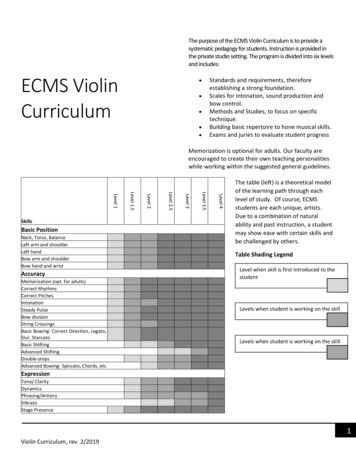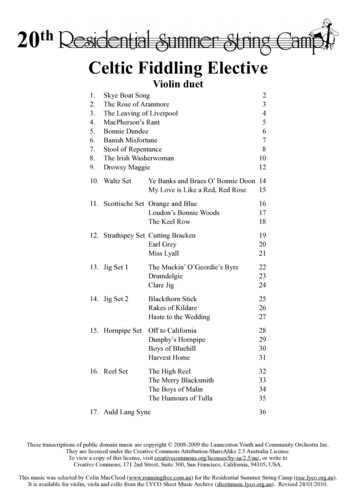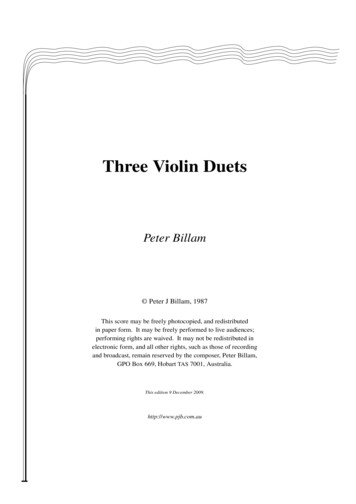
Transcription
The violin making manualMakingTheViolin.comTools &materialsFrontBackTemplatesMould &blocksRibsNeck &scrollAssemblyVarnishingAntonio StradivariThe Messiah1716Forewordand 63.Setup03.62.cMeasurements1By Vojtěch Blahout, v. 2016234567WWW891011Forum
Home - F orewordWelcome!The purpose of this guide is to give basic information about violin making. The aspiring violin maker willStradivari Messiah 1716have the opportunity to build an instrument from start to finish with the help of step by step tutorialsaccompanied by drawn images.To make the best of the electronic format, all the images are in vector graphic format SVG, drawn toexact real world dimensions. At every step of you building experience you can print out the plans anddrawings and use them in direct comparison with what you have at hand. The SVG graphic format issupported by most modern browsers and editable by the free Inkscape.My goal was to create a site that would give starting points to those interested in violin making. Thework is by no means complete. There is always room for improvement and I encourage anyone who feelthey might be able to contribute to do so, either by commenting on the pages, or sending theircontributions to me at vojtech.blahout@gmail.com. All additions will be duly credited.Together, we can make this site a rich, structured information source on violin making.Enjoy your stay,Vojtech BlahoutPS: You can now download the whole site as a PDF, see the link "PDF" on the front page.Frequently ask ed questionsQ I have a question/I don't understand what you mean by XY. Where do I get an answer?A If your question or a comment is about a section of the manual, please feel free to post a commenton the appropriate page or register in the forum and ask your question there. I will try to get back toyou as soon as possible. Or you can always contact me by email vojtech.blahout@gmail.com.Q I want to edit or add to the content on the website, where is the registration?A Due to massive spam attacks, I was forced to close down this option. Please send me an email andI'll set up an account for you. Commenting, at the bottom of every page, is available withoutregistration, at least for now.Q I want to use the images on this site in my own project, presentation.A By all means, use whatever you need, but please consider linking back here or using any othersuitable way to acknowledge the source. You can edit the images in Inkscape.Q I see no images on the right side of the text.A If you are having problems viewing the images, clickhttp://caniuse.com/svg to see whether yourbrowser is supported. With some browsers, ie. Internet Explorer 6-8 there is the option to install theAdobe SVG ewer-download-area.html tocorrectly render the images.Q I use Internet Explorer and some of the images have wrong aspect ratio.A Please, if you can, use Chrome or Firefox to view the site. I haven't found a reliable method todisplay the SVG images across all browsers. The SVG rendering will hopefully get in line with otherbrowsers in the next release of the browser. Clicking on the image will display the correct full sizeversion even in Internet Explorer.Q I'm not sure my printer is precise enough to print the plans.A Please click on this Test file and print it out on your printer. Check that the ruler matches yours. If itdoesn't you need to find a way to scale the output, usually in the printer's settings, so that the printoutpasses the comparison test.MakingTheViolin.com
Home - Tools and materialsTools andmaterials1.Terminology2.Tools3.Sharpening4.Hide glue5.Specific gravity calculatorMakingTheViolin.com
Home - Tools and materials- Terminology1ChamferFirst turnSecond turnFlutingVoluteCenter ridgeFinal turnOutter wallScrollInner wallShaftPegbox floorPegboxNeck end wallNutCollar Peg headFingerboardNeckButtonShoulderTop blockOverhangTop plateUpperboutsPurflingCornerBee stingTipBodyC boutsUpper wingUpper eyeStemBridge positionF holeNotchCorner blockStemLower eyeSound postLower wingTipLowerboutsTailpieceBass barBottom blockSaddleEnd buttonTreble sideBass side2EyeFirst turnChamferSecond turnVoluteCommaFinal turnThroatScrollVolute end wallChinPegbox wallPegbox floorPegboxPeg holeNeck end wallNutDuck tailNapeNeckFingerboardNeckHeelButtonNeck rootRibsUpperboutsBack plateCornerBodyC boutsC ribsStringsBridgeLowerboutsTailpieceEnd buttonTailgutCategory: Tools and materialsMakingTheViolin.com
Home - Tools and materials- SharpeningWhen sharpening any instrument, there are two important aspects. You want the edge to beas keen as possible and you also want it to be the ideal shape.1The sharpening of any tool takes generally two steps: Shaping and/or nick removal andHoning.cbTerminologyadSee Fig. 1 for the basic bevel up tool geometry. Bevel up tools include chisels, gouges andblock planes. "a" - Primary bevel angle, "b" - Cutting angle, "c" - Secondary bevel /microbevel/, "d" - Back bevel.See Fig. 2 for the basic bevel down tool geometry. Bevel down tools include smoothing andjointer planes. "a" - Bevel angle, "b" - Cutting angle.21. Initial shaping or nick removalIn this step you decide the angle of the bevel. You also remove any nicks and irregularitiesbmaking the shape of the tip perfect.aShaping equipment you needIf you want the bare bones setup, get a bench dual water stone 1000/4000. It shouldmeasure at least 20 x 6 cm. Or even cheaper is a 600 grit sandpaper mounted on a block ofwood.If you want to go electric, for large mass removals, wet grinders are the best. There is noneed to fear for overheating, but they are rather slow. Sides of the wheel can be used for flat3surfaces. Cheap ones use vitrified stones which are less efficient but degrade more slowly.baWhen you use your normal dry grinder, overheating is a great risk. When that happens, thecarbon in the steel combines with oxygen leaving you with just soft iron, plus you anneal thetip making it soft. The whole length where this occurs should always be removed. Also,quenching tips in water during dry grinding leads to tearing. The tip should be in contact withthe coolant at all times, so don't use dry grinders unless you really know what you're doing.If you must use a cheap dry grinder, at least change the wheel for something like Norton38A80 and buy a separate tool rest. If glazing occurs, which can happen when you grindbrass or with cheap grinders a diamond wheel dresser should be used to restore the wheel. It4can also be used to remove any humps on the wheel.Belt sanders can on many occasions be used instead of bench grinders.ShapingThe shape and the bevel depend on the metal used but also on the use of the instrument.Japanese instruments are usually harder 62RC allowing for a keener edge, so a bevel ofhigher 45 angle is needed to prevent breaking. With western blades which are a bit softer,aand less prone to chipping, the bevel angle can be less, say 25 .Cutting the denser sorts of wood requires blunter bevel angles, whereas softer woods allowfor more sharply beveled tips. Ideally, the sharpest bevel should be employed which makesthe tip still strong enough to withstand the pressure of the wood.2. HoningDuring honing you make the bevels smooth as a mirror. Then you create the micro bevel,making the tip as sharp as possible.Honing equipment you needThe cheapest tools would be strops, leather or even better wooden. Cut a groove in asoftwood, maybe basswood, apply chromium oxide compound and you have a perfectlyshaped strop for honing. The same for the inner side. In seconds, you can make a woodenstrop that fits perfectly the shape of your gouge.For chisels and plane irons, if you can, buy a honing guide. It will help you make the bevelsaccurate and lead to consistent micro bevels.An electrified alternative is the use of shaped felt wheels, which are ideal for honing theinside of gouges. They are a great substitute for the fine bench stones. The to of the wheelshould rotate away from you. Belt sanders are great for honing with leather belts.Micro bevelsMicro bevels save time, tools and energy. The finest possible edge in the shortest time. If youneed fine angular control, use a honing guide. Only takes half a dozen strokes.Sharpening tools specificsChisels1. If new, remove the lacquer.2. Lap the face so that the edge is not jagged. Make sure the stone is flat.3. Fix the nicked chisels on your bench stone or wet grinder.4. Hone.A chisel should always be at the lowest bevel angle consistent with edge retention. Bevelangle should be higher for narrower chisels, say 30 , to prevent chipping.Japanese chisels are usually made of hard steel face combined with an iron back which addtoughness and flexibility to the chisel. The chisels are usually very hard 62-RC and thereforequite brittle. They are usually sharpened at higher bevel angles. Ideal for softwoods. Most ofthem are hollow on their face with just a couple of mm of a platform adjacent to the tip, toease sharpening.PlanesWith a new plane you will probably need to lap the sole. It is usually hollow. You don't need toflatten the whole sole, but at the beginning, right before the mouth and at the end the solemust touch. Use 90 grit on a sheet of glass, iron plate or stone.True the bed. Put some paint on the iron, insert in position, remove and see there it imprints.Carbon paper.Dress the lever cap so that it is in perfect contact with the chip-breaker.True the chip-breaker. At an angle that makes the point of contact at the very end. Have it setas close to the keen edge as possible, maybe 1mm, because the closer it is the smaller willthe broken particles be resulting in smoother surface.Sharpening the iron:1. If new, remove the lacquer.2. Lap the face so that the edge is not jagged. Make sure the stone is flat.3. Fix the nicked chisels on your bench stone or wet grinder.4. Bevel down bench planes Stanley no 7, have the usual grind angle of 30-35.Block planes such as the Stanley low angle 60 1/2 plane can be ground to 20 bevel and5 back bevel to reinforce the tip. Make sure the iron sits in the bed perfectly.5. Hone.KnivesFor your knives a bench water stone, double 1000/4000 is alright. The bevels can rangebetween 10 -30 depending on the steel and application. If you are concerned about theconsistency of your bevels, you can use a spine clamp from you local stationery store. Putthe clamp on the back of your knife to serve as an angular guide.Honing can be done the cheapest on a leather strap glued do a wooden block, dressed withchromium oxide.Gouges1. Bevel angle of 15 for soft woods and 25 for hard woods, 30 -35 with a mallet. All around25 . In order to achieve the lowest bevel angle possible and the lowest gouge angle forthe easiest cut, make the outside bevel 15 and the inside 10 . The inside bevel reinforcesthe tip and at the same time lowers the gouge angle required for a cut to 15 . This lowattack angle requires less pressure on the gouge and makes your cuts more precise.2. You may also decide to change the shape of the tip's end. Square end is good for mostpurposes, fingernail end may be better for the scroll.3. To hone the gouges, either use a leather belt charged with chromium oxide on an electricbelt sander. If you prefer manual, go with the wooden strop charged with chromium oxide.For the inside flute, a shaped felt wheel charged with chromium oxide is good. again goingmanual, cut the edge of a scrap wood which reflects the shape of the inside of the gougeperfectly. Dress with chromium oxide.ScrapersA well sharpened scraper should make clean shavings, not dust. In hardness RCs of up to 52are now available. To create the edge, you need to burnish the scraper. Use a round burnisheror RC60. Don't use the backs of you chisels, they most likely are not hard enough. Don't usescrewdrivers as the chromium/nickel coating is thin.1. Joint the scraper first to give it a smooth edge at 90 to the sides. A jointing jig can beused with square scrapers.2. You can stone the surface, at the side of the bench stone. 1000x3. Put some nose grease on the burnisher.4. Clamp the scraper in the vice, and make a couple of strokes parallel to the scrapers edgewith the burnisher slightly tilted as in fig. Hold it by the handle with one hand and by thetip with the other. Move the burnisher in a little to avoid using just one spot on it. In softerscrapers this will result in a small hook on both sides. With greater angles the scraper willhave to be tilted more to the ground to bite. Use as few passes as possible. Try thescraper on the wood you intend to use it for.5. If you need more hook, run the burnisher at a slight 2 -10 angle to the edge. Do that acouple of times. Check again.To "pick up" the hook after it has become dull, reburnish again with a few strokes. If thatdoesn't help any more remove the hook with the jointing jig, stone and burnish again.Scraper planeThe scraper plane can be used when thicknessing the ribs. A 45 bevel is usually used. Ontop of that, you can create a hook at the end with your burnisher angled at 15 .Stone truingAfter a while every stone will loose its flatness. This may not be a big deal with gouges, butwhen sharpening chisels or plane irons, the stone must be reasonably flat. To true your stone,you can sue a coarse diamond bench stone, silicon/carbide paper on glass or even coarserstones, which can true your finer one.Wood cutting tipsWhen parallel grain cutting, always cut with the grain, that is when the grain is rising upaway from you.If cutting end grain, always consider the skew cut. It is less demanding of the edge andlowers the bevel angle further.When planing keep the mouth just wide enough for the shaving. This also results in smallerparticles, smoother surface. Take thin shavings, they also allow for tighter mouth. Skew theplane wherever applicable. This applies especially if you have to cut against the grain.Use a low angle plane, when cutting end grain.For the
Then, using a 25 mm drill bit, to avoid splitting, start a hole on the top, drilling about 1/3 in, then flip the mould and finish. 4.The four "e1-e4" holes should now be predrilled with a 2 mm bit. Four screws will be later used here to elevate the mould above the workbench surface a bit when attaching the blocks.











